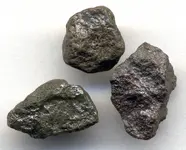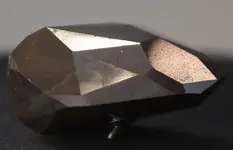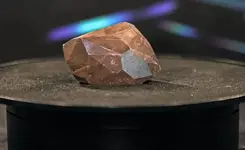The seller is suggesting it to be a ‘carbonado’ diamond. It isn’t. True carbonados are only found in Brazil and the Central African Republic although carbonado diamondites in general have a wider distribution, as do conventional 'black' diamonds. Their ‘cosmic’ origin (whether by arrival from space or formed by a massive impact on Earth) is not proven but it’s interesting to note that these two regions were physically connected as part of the continent of Gondwana at the time of the believed geological age of this type of diamond and might represent a single impact location.
They don’t look like the seller’s picture though. Carbonados are impure, poly-crystalline, micro-porous and usually contain foreign inclusions of reduced metals. These would be typical uncut ‘rough’ stones:

[Picture by James St. John – Wikipedia; Creative Commons License]
Because of their structural and compositional nature they don’t make for particularly good gemstones, although they can be cut after a fashion. The reference in the seller’s description to one selling for $3 million relates to a carbonado of poorly documented origin that was sold as a 555.55 carat cut stone named “The Enigma” in February this year. It fetched £3.16 million (pounds sterling), or $4.3 million (US dollars) and was purchased using digital cryptocurrency by the American entrepreneur Richard Heart who renamed it the “HEX.com diamond” after his blockchain organization.


It's actually a very dark brown rather than true black (most black diamonds sold in jewellery are not true carbonados and have been artificially enhanced) and is still, I believe, the largest cut diamond in the world although it’s not known how big it was before cutting. The cut is unconventional for several reasons, including the geological nature of the stone and the desire for a record-breaking weight (versus the “Golden Jubilee” diamond at 545.67 carats). According to Ran Gorenstein who commissioned the design, the 555.5 carats based around a five facet cut was inspired by the “hamsa”, a palm shaped amulet popular among Muslims and Jews in the Middle East and North Africa.
[Incidentally, a carbonado still (I think) holds the record for the largest rough diamond ever found. The stone was found in Brazil in 1895 and dubbed “Sergio” after the finder Sérgio Borges de Carvalho. Originally it was 3,167 carats (versus the Cullinan Diamond at 3,107 carats) but was purchased in September 1895 by I. K. Gulland of London for £6,400 and broken up into 3 - 6 carat pieces for use in industrial diamond drills. Like most carbonados, its composition and structure was unsuited to cutting as a gem.]

 www.facebook.com
www.facebook.com

 www.facebook.com
www.facebook.com








